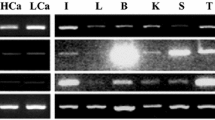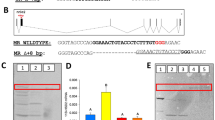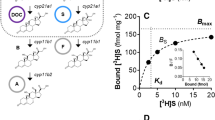Abstract
Freshwater fish live in environments where pH levels fluctuate more than those in seawater. During acidic stress, the acid–base balance in these fish is regulated by ionocytes in the gills, which directly contact water and function as an external kidney. In ionocytes, apical acid secretion is largely mediated by H+-ATPase and the sodium/hydrogen exchanger (NHE). Control of this system was previously proposed to depend on the hormone, cortisol, mostly based on studies of zebrafish, a stenohaline fish, which utilize H+-ATPase as the main route for apical acid secretion. However, the role of cortisol is poorly understood in euryhaline fish species that preferentially use NHE as the main transporter. In the present study, we explored the role of cortisol in NHE-mediated acid secretion in medaka larvae. mRNA expression levels of transporters related to acid secretion and cortisol-synthesis enzyme were enhanced by acidic FW treatment (pH 4.5, 2 days) in medaka larvae. Moreover, exogenous cortisol treatment (25 mg/L, 2 days) resulted in upregulation of nhe3 and rhcg1 expression, as well as acid secretion in 7 dpf medaka larvae. In loss-of-function experiments, microinjection of glucocorticoid receptor (GR)2 morpholino (MO) caused reductions in nhe3 and rhcg1 expression and diminished acid secretion, but microinjection of mineralocorticoid receptor (MR) and GR1 MOs did not. Together, these results suggest a conserved action of cortisol and GR2 on fish body fluid acid–base regulation.





Similar content being viewed by others
References
Al-FiFi ZIA (2006) Studies of some molecular properties of the vacuolar H+-ATPase in rainbow trout (Oncorhynchus mykiss). Biotechnology 5(4):455–560
Aruna A, Nagarajan G, Chang CF (2012) Differential expression patterns and localization of glucocorticoid and mineralocorticoid receptor transcripts in the osmoregulatory organs of tilapia during salinity stress. Gen Comp Endocrinol 179(3):465–476
Baker ME (2003) Evolution of glucocorticoid and mineralocorticoid responses: go fish. Endocrinology 144:4223–4225
Brown SB, Eales JG, Hara TJ (1986) A protocol for estimation of cortisol plasma clearance in acid-exposed rainbow trout (Salmo gairdneri). Gen Comp Endocrinol 62:493–502
Bury NR, Sturm A, Le Rouzic P, Lethimonier C, Ducouret B, Guiguen Y, Robinson-Rechavi M, Laudet V, Rafestin-Oblin ME, Prunet P (2003) Evidence for two distinct functional glucocorticoid receptors in teleost fish. J Mol Endocrinol 31:141–156
Chang WJ, Hwang PP (2011) Development of zebrafish epidermis. Birth Defects Res C Embryo Today 93(3):205–214
Cruz SA, Chao PL, Hwang PP (2013a) Cortisol promotes differentiation of epidermal ionocytes through Foxi3 transcription factors in zebrafish (Danio rerio). Comp Biochem Physiol A Mol Integr Physiol 164:249–257
Cruz SA, Lin CH, Chao PL, Hwang PP (2013b) Glucocorticoid receptor, but not mineralocorticoid receptor, mediates cortisol regulation of epidermal ionocyte development and ion transport in zebrafish (Danio rerio). PLoS ONE 8(10):e77997
Evans DH, Piermarini PM, Choe KP (2005) The multifunctional fish gill: dominant site of gas exchange, osmoregulation, acid-base regulation, and excretion of nitrogenous waste. Physiol Rev 85:97–177
Furukawa F, Watanabe S, Inokuchi M, Kaneko T (2011) Responses of gill mitochondria-rich cells in Mozambique tilapia exposed to acidic environments (pH 4.0) in combination with different salinities. Comp Biochem Physiol A Mol Integr Physiol 158:468–476
Galvez F, Reid SD, Hawkings G, Goss GG (2002) Isolation and characterization of mitochondria-rich cell types from the gill of freshwater rainbow trout. Am J Physiol Regul Integr Comp Physiol 282:R658–R668
Gilmour KM, Collier CL, Dey CJ, Perry SF (2011) Roles of cortisol and carbonic anhydrase in acid–base compensation in rainbow trout, Oncorhynchus mykiss. J Comp Physiol B 181(4):501–515
Greenwood AK, Butler PC, White RB, DeMarco U, Pearce D, Fernald RD (2003) Multiple corticosteroid receptors in a teleost fish: distinct sequences, expression patterns, and transcriptional activities. Endocrinology 144:4226–4236
Hirata T, Kaneko T, Ono T, Nakazato T, Furukawa N, Hasegawa S, Wakabayashi S, Shigekawa M, Chang MH, Romero MF, Hirose S (2003) Mechanism of acid adaptation of a fish living in a pH 3.5 lake. Am J Physiol Regul Integr Comp Physiol 284:R1199–R1212
Horng JL, Lin LY, Huang CJ, Katoh F, Kaneko T, Hwang PP (2007) Knockdown of V-ATPase subunit A (atp6v1a) impairs acid secretion and ion balance in zebrafish (Danio rerio). Am J Physiol Regul Integr Comp Physiol 292:R2068–R2076
Hsiao CD, You MS, Guh YJ, Ma M, Jiang YJ, Hwang PP (2007) A positive regulatory loop between foxi3a and foxi3b is essential for specification and differentiation of zebrafish epidermal ionocytes. PLoS ONE 2(3):e302
Hsu HH, Lin LY, Tseng YC, Horng JL, Hwang PP (2014) A new model for fish ion regulation: identification of ionocytes in freshwater- and seawater-acclimated medaka (Oryzias latipes). Cell Tissue Res 357(1):225–243
Hwang P-P, Chou M-Y (2013) Zebrafish as an animal model to study ion homeostasis. Pflügers Arch Eur J Physiol 465(9):1233–1247. https://doi.org/10.1007/s00424-013-1269-1
Hwang PP, Perry SF (2010) Ionic and acid–base regulation. In: Perry SF, Ekker M, Farrell AP, Brauner CJ (eds) Fish physiology Vol. 29. Zebrafish. Academic Press, San Diego, pp 311–343
Hwang PP, Lee TH, Lin LY (2011) Ion regulation in fish gills: recent progress in the cellular and molecular mechanisms. Am J Physiol Regul Integr Comp Physiol 301:R28–R47
Inokuchi M, Hiroi J, Watanabe S, Hwang PP, Kaneko T (2009) Morphological and functional classification of ion-absorbing mitochondria-rich cells in the gills of Mozambique tilapia. J Exp Biol 212:1003–1010
Ito Y, Kato A, Hirata T, Hirose S, Romero MF (2014) Na+/H+ and Na+/NH4+ activities of zebrafish NHE3b expressed in Xenopus oocytes. Am J Physiol Regul Integr Comp Physiol 306:R315–R327
Ivanis G, Esbaugh AJ, Perry SF (2008) Branchial expression and localization of SLC9A2 and SLC9A3 sodium/hydrogen exchangers and their possible role in acid-base regulation in freshwater rainbow trout (Oncorhynchus mykiss). J Exp Biol 211:2467–2477
Izumi Y, Hori K, Nakayama Y, Kimura M, Hasuike Y, Nanami M, Kohda Y, Otaki Y, Kuragano T, Obinata M, Kawahara K, Tanoue A, Tomita K, Nakanishi T, Nonoguchi H (2011) Aldosterone requires vasopressin V1a receptors on intercalated cells to mediate acid-base homeostasis. J Am Soc Nephrol 22(4):673–680
Kiilerich P, Kristiansen K, Madsen SS (2007) Cortisol regulation of ion transporter mRNA in Atlantic salmon gill. J Endocrinol 194:417–427
Kumai Y, Nesan D, Vijayan MM, Perry SF (2012) Cortisol regulates Na+ uptake in zebrafish, Danio rerio, larvae via the glucocorticoid receptor. Mol Cell Endocrinol 364:113–125
Kwon HJ, Bhat N, Sweet EM, Cornell RA, Riley BB (2010) Identification of early requirements for preplacodal ectoderm and sensory organ development. PLoS Genet 6:e1001133
Lee YC, Yang JJ, Cruze S, Horng JL, Hwang PP (2011) Anion exchanger 1b, but not sodium-bicarbonate cotransporter 1b, plays a role in transport functions of zebrafish H+-ATPase-rich cells. Am J Physiol Cell Physiol 300:C295–C307
Lin CH, Hwang PP (2016) The control of calcium metabolism in Zebrafish (Danio rerio). Int J Mol Sci 17:1783
Lin H, Randall DJ (1993) Proton-ATPase activity in crude homogenates of fish gill tissue: inhibitor sensitivity and environmental and hormonal regulation. J Exp Biol 180:163–174
Lin GR, Weng CF, Wang JI, Hwang PP (1999) Effectsof cortisol on ion regulation in developing tilapia (Oreochromis mossambicus) larvae. Physiol Biochem Zool 72:397–404
Lin LY, Horng JL, Kunkel JG, Hwang PP (2006) Proton pump-rich cell secretes acid in skin of zebrafish larvae. Am J Physiol Cell Physiol 290:C371–C378
Lin CH, Tsai IL, Su CH, Tseng DY, Hwang PP (2011) Reverse effect of mammalian hypocalcemic cortisol in fish: cortisol stimulates Ca2+ uptake via glucocorticoid receptor-mediated vitamin D3 metabolism. PLoS ONE 6:e23689
Lin CC, Lin LY, Hsu HH, Thermes V, Prunet P, Horng JL, Hwang PP (2012) Acid secretion by mitochondrion-rich cells of medaka (Oryzias latipes) acclimated to acidic freshwater. Am J Physiol Regul Integr Comp Physiol 302(2):R283–R291
Lin CH, Shih TH, Liu ST, Hsu HH, Hwang PP (2015) Cortisol regulates acid secretion of H+-ATPase-richionocytes in zebrafish (Danio rerio) embryos. Front Physiol 6:328
Lin CH, Hu HJ, Hwang PP (2016) Cortisol regulates sodium homeostasis by stimulating the transcriptionof sodium-chloride transporter (NCC) in zebrafish (Danio rerio). Mol Cell Endocrinol 422:93–102
Liu ST, Horng JL, Chen PY, Hwang PP, Lin LY (2016) Salt secretion is linked to acid-base regulation of ionocytes in seawater-acclimated Medaka: new insights into the salt-secreting mechanism. Sci Rep 6:31433
Nelson DR (2003) Comparison of P450s from human and fugu: 420 million years of vertebrate P450 evolution. Arch Biochem Biophys 409:18–24
Nesan D, Kamkar M, Burrows J, Scott IC, Marsden M, Vijayan MM (2012) Glucocorticoid receptor signaling is essential for mesoderm formation and muscle development in zebrafish. Endocrinology 153:1288–1300
Perry SF, Gilmour KM (2006) Acid–base balance and CO2 excretion in fish: unanswered questions and emerging models. Respir Physiol Neurobiol 154:199–215
Shih TH, Horng JL, Hwang PP, Lin LY (2008) Ammonia excretion by the skin of zebrafish (Danio rerio) larvae. Am J Physiol Cell Physiol 295:C1625–C1632
Shih TH, Horng JL, Liu ST, Hwang PP, Lin LY (2012) Rhcg1 and NHE3b are involved in ammonium-dependent sodium uptake by zebrafish larvae acclimated to low-sodium water. Am J Physiol Regul Integr Comp Physiol 302:R84-93
Sturm A, Bury NR, Dengreville L, Fagart J, Flouriot G, Rafestin-Oblin ME, Prunet P (2005) 11-Deoxycorticosterone is a potentagonist of the rainbow trout (Oncorhynchus mykiss) mineralocorticoid receptor. Endocrinology 146:47–55
Trayer V, Hwang PP, Prunet P, Thermes V (2013) Assessment of the role of cortisol and corticosteroid receptors in epidermal ionocyte development in the medaka (Oryzias latipes) embryos. Gen Comp Endocrinol 194:152–161
Tseng YC, Yan JJ, Furukawa F, Hwang PP (2020) Did acidic stress resistance in vertebrates evolve as Na+/H+ exchanger-mediated ammonia excretion in fish? BioEssays 42:e1900161
Wang D, Zhang H, Lang F, Yun CC (2007) Acute activation of NHE3 by dexamethasone correlates with activation of SGK1 and requires a functional glucocorticoid receptor. Am J Physiol Cell Physiol 292(1):C396-404
Warren DE, Matsumoto S, Roessig JM, Cech JJ (2004) Cortisol response of green sturgeon to acid-infusion stress. Comp Biochem Physiol A 137:611–618
Wood CM, Milligan CL, Walsh PJ (1999) Renal responses of trout to chronic respiratory and metabolic acidoses and metabolic alkalosis. Am J Physiol 277:R482–R492
Wu SC, Horng JL, Hwang PP, Wen ZH, Lin CS, Lin LY (2010) Ammonium-dependent sodium uptake in mitochondrion-rich cells of medaka (Oryzias latipes) larvae. Am J Physiol Cell Physiol 298:C237-250
Yan JJ, Hwang PP (2019) Novel discoveries in acid-base regulation and osmoregulation: a review of selected hormonal actions in zebrafish and medaka. Gen Comp Endocrinol 277:20–29
Yan JJ, Chou MY, Kaneko T, Hwang PP (2007) Gene expression of Na+/H+ exchanger in zebrafish H+-ATPase-rich cells during acclimation to low-Na+ and acidic environments. Am J Physiol Cell Physiol 293:C1814–C1823
Acknowledgements
This work was supported by Grants (to PPH and CHL) from the Ministry of Science and Technology of Taiwan (MOST107-2326-B-001-007 and MOST109-2313-B-992- 003-MY3)
Author information
Authors and Affiliations
Contributions
CHL and PPH were involved in conception and study design; CHL, HJH, HJC, and YLT carried out the experiments and data collection; CHL, HJH, HJC, and PPH did the data analysis and interpretation; CHL and PPH wrote the manuscript; All the authors reviewed and revised the manuscript, and gave final approval for publication.
Corresponding authors
Ethics declarations
Conflict of interest
The authors declare no conflict of interests.
Ethical approval
All applicable national and/or institutional guidelines for the care and use of animals were followed.
Additional information
Communicated by B. Pelster.
Publisher's Note
Springer Nature remains neutral with regard to jurisdictional claims in published maps and institutional affiliations.
Rights and permissions
About this article
Cite this article
Lin, CH., Hu, HJ., Chuang, HJ. et al. Cortisol and glucocorticoid receptor 2 regulate acid secretion in medaka (Oryzias latipes) larvae. J Comp Physiol B 191, 855–864 (2021). https://doi.org/10.1007/s00360-021-01390-w
Received:
Revised:
Accepted:
Published:
Issue Date:
DOI: https://doi.org/10.1007/s00360-021-01390-w




